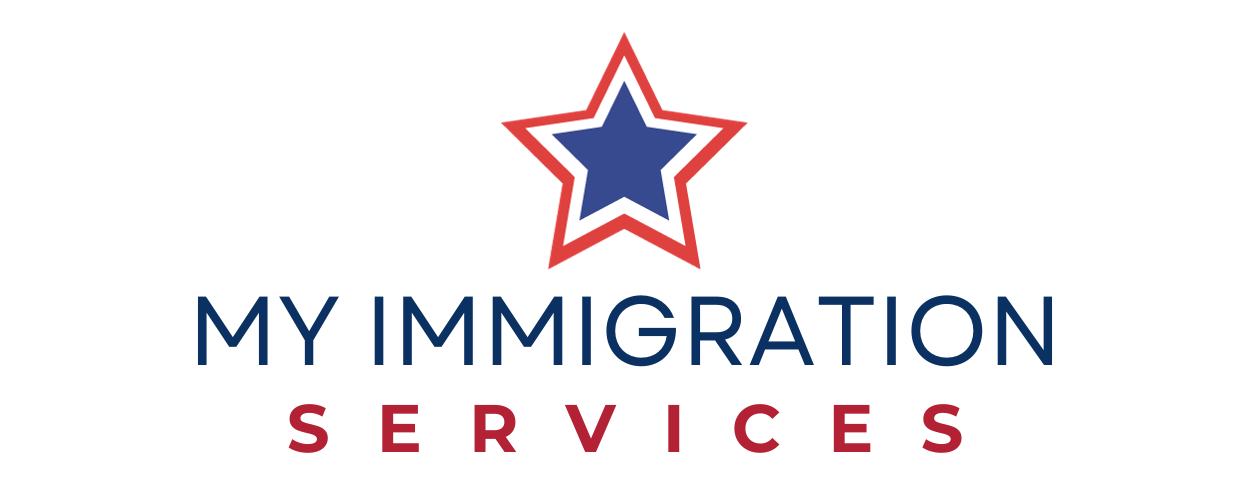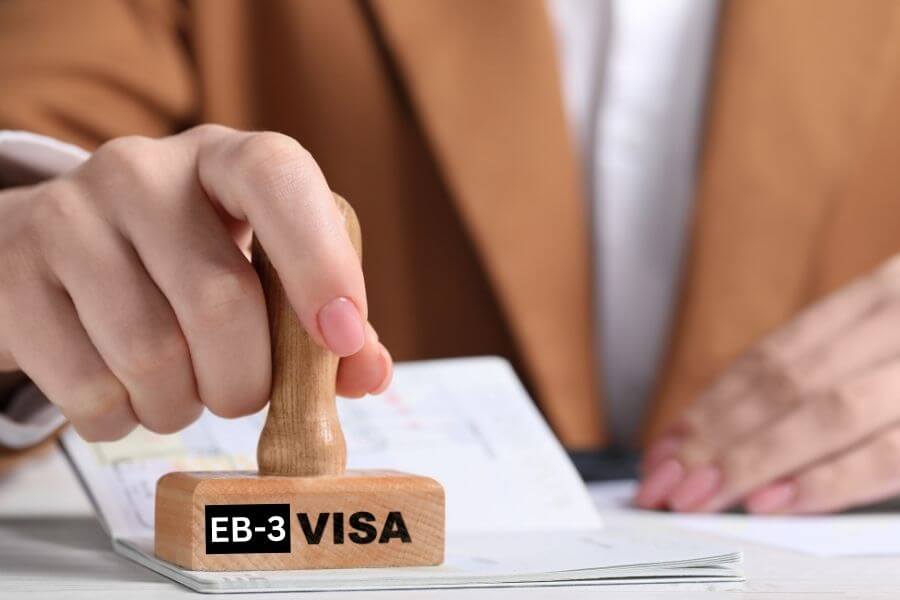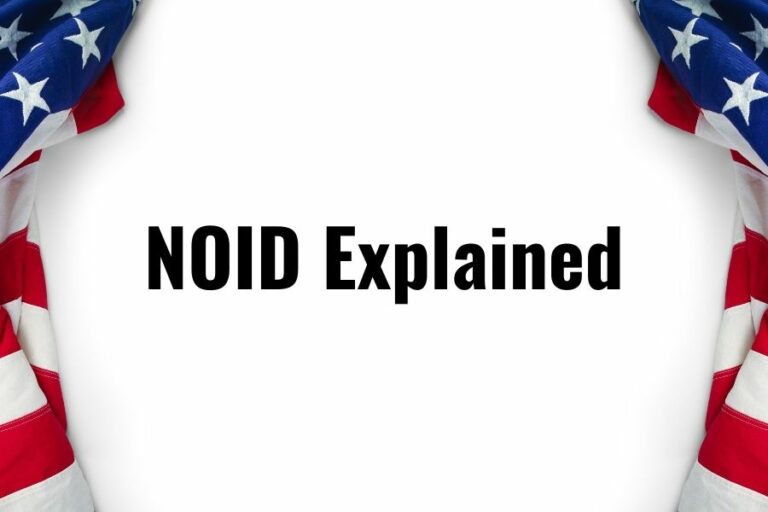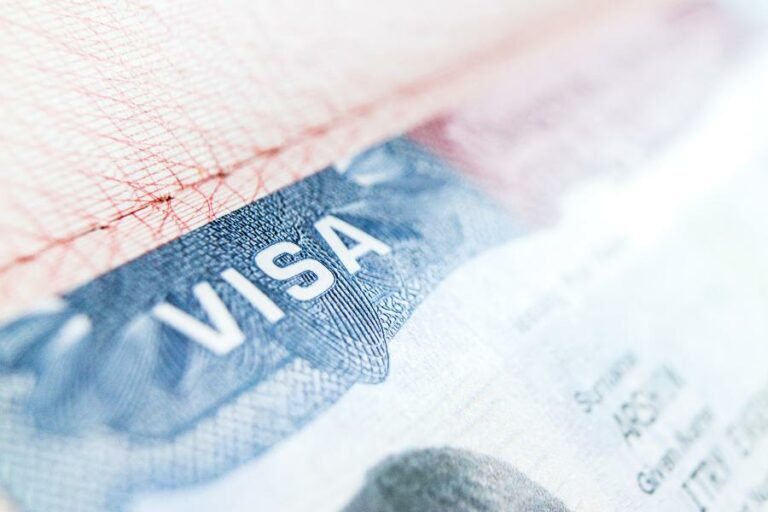EB-3 Visa: Everything You Need To Know
Among the pathways to U.S. permanent residency, the EB-3 visa stands out as a preferred option for skilled professionals, workers with relevant experience, and even certain unskilled workers.
This employment-based immigrant visa not only offers a chance to work and live in the U.S. permanently but also paves the way for bringing families together.
Dive into the EB-3 visa, its categories, and the process, as we explore how it serves as a bridge to the American dream for many around the globe.

What is the EB-3 visa?
The EB-3 visa, or Employment-Based Third Preference visa, is a United States immigrant visa designed for skilled workers, professionals, and unskilled or “other” workers seeking permanent residency.
Established for those who might not meet the stringent requirements of the EB-1 or EB-2 categories, the EB-3 visa serves as an essential bridge for many foreign nationals looking to establish lasting roots in the U.S.
This visa category prioritizes candidates with a combination of experience, educational qualifications, and a genuine job offer from a U.S. employer.
The Different Categories of EB-3 Visas (& Job Examples)
The EB-3 (Employment-Based Third Preference) visa has three distinct subcategories:
EB-3A: Skilled Workers
- For individuals with at least two years of job experience or training in a specific skilled occupation.
- The position being offered should not be of a temporary or seasonal nature.
- The foreign worker must meet the educational, training, or experience requirements of the job.
Job examples include:
- Chefs or cooks
- Computer technicians
- Medical technologists
- Electricians
- Plumbers
- Machinists
EB-3B: Professionals
- For individuals with a U.S. bachelor’s degree or its foreign equivalent, where the degree is the normal requirement for entering the occupation.
- The applicant must be performing work in a profession that typically requires at least a bachelor’s degree.
- Education and experience may not be substituted for the degree.
Job examples include:
- Engineers
- Teachers
- Accountants
- Lawyers
- Physicians
- Nurses with bachelor’s degrees (Note: Nurses can also qualify under the EB-2 category if they meet certain advanced criteria.)
- Software developers with a bachelor’s degree
EB-3C: Other Workers
- For unskilled workers (occupations requiring less than two years of training or experience).
- Despite being part of the EB-3 category, this subcategory often has a longer waiting time for visa availability than the Skilled Workers and Professionals subcategories, due to annual visa caps.
Job examples include:
- Housekeepers
- Janitors
- Farm laborers
- Manual laborers
- Certain types of construction workers
How to apply for an EB-3 visa
The process for applying for an EB-3 visa involves multiple steps, usually initiated by the U.S. employer who is sponsoring the foreign national for permanent residency. Here’s a step-by-step overview of the application process:
Step #1: Filing the Labor Certification (PERM Application):
- The U.S. employer must first obtain a Labor Certification from the Department of Labor (DOL).
- This involves conducting recruitment efforts to ensure that no qualified U.S. workers are available and willing to take the job.
- Once recruitment efforts are complete and other requirements are met, the employer submits the PERM application to the DOL.
- If approved, the Labor Certification confirms there’s no adverse effect on U.S. workers by hiring the foreign national.
Step #2: Filing the I-140 Immigrant Petition:
- With the approved Labor Certification in hand, the employer then files the I-140 Immigrant Petition for Alien Worker with the U.S. Citizenship and Immigration Services (USCIS).
- This petition demonstrates the employer’s ability to pay the proffered wage and establishes the basis for the beneficiary’s immigration (i.e., as a skilled worker, professional, or other worker).
- Once the I-140 is approved, the beneficiary gets a “priority date,” which is essential for the next steps.
Step #3: Waiting for a Visa Number:
- Based on the “priority date” and the U.S. Department of State’s Visa Bulletin, the applicant must wait until a visa number becomes available.
- The waiting time varies based on the demand for EB-3 visas, especially from the beneficiary’s country of birth.
Step #4: Applying for Adjustment of Status (I-485) or Consular Processing:
- If the applicant is already in the U.S. (Adjustment of Status), they can apply for an Adjustment of Status using the form I-485 when their priority date becomes current.
- If the applicant is outside the U.S. (Consular Processing), they will need to go through consular processing at a U.S. embassy or consulate in their home country. In this case, you can apply anytime.
Step #5: Medical Examination and Interview:
- Whether going through adjustment of status or consular processing, the applicant will need to undergo a medical examination by an approved physician.
- Additionally, an interview will usually be scheduled either at a USCIS office (for adjustment of status) or at a U.S. consulate or embassy (for consular processing).
Step #6: Receiving the Green Card:
- If the application is approved after the interview, the foreign national receives the green card, granting them permanent residency in the U.S.
- For those in the U.S., the physical green card is mailed. For those outside the U.S., they will receive a visa stamp on their passport and will get the physical green card once they enter the U.S.
It’s essential to keep in mind that due to the complexity of the process and the potential for delays or issues, many applicants work with immigration attorneys to navigate the EB-3 application process.
Additional Optional Forms (I-765 & I-131):
- Form I-765 (EAD): While waiting for the Adjustment of Status (I-485) application to be processed, which can take several months or even years, an applicant can file Form I-765 to request permission to work in the U.S. This form is for the Employment Authorization Document, commonly known as a work permit.
- Form I-131 (Advance Parole): If an applicant needs to travel outside the U.S. while their I-485 is pending and they do not have a valid H-1B, L-1, or similar visa, they would need to apply for Advance Parole to ensure they can re-enter the U.S. without jeopardizing their pending I-485 application.
The forms I-765 (Employment Authorization Document, or EAD) and I-131 (Advance Parole) are not primary steps in the EB-3 visa application process itself. Instead, they are related to benefits that an applicant can apply for while their primary application for Adjustment of Status (I-485) is pending. Here’s a brief breakdown:
Advance Parole is a permit allowing certain immigrants to re-enter the U.S. after traveling abroad without needing a visa. It’s mainly used by those with a pending adjustment of status application (Form I-485) to become a permanent resident, particularly if they lack a valid non-immigrant visa or face potential readmission issues.

EB-3 Visa Processing Times
The processing time for an EB-3 visa can vary widely based on several factors. Here’s a breakdown of the typical steps involved and the potential time frames:
| Step | Duration/Remarks |
| Labor Certification (PERM Application) | 6 to 9 months (longer if application gets audited by DOL) |
| I-140 Immigrant Petition | 6 to 9 months (or 15 days with premium processing – Form I-907) |
| Priority Date and Visa Bulletin Wait | Varies greatly year-by-year. Can be quick, or many years, especially for countries with high demand like India, China, Mexico, or the Philippines, or during times when EB-3 visas are in high demand. Check the current Visa Bulletin. |
| Medical Examination | For those in the U.S. (Adjustment of Status): Exam by a USCIS authorized physician before submitting I-485. Typically, results are valid for 2 years. For those outside the U.S. (Consular Processing): Done before the visa interview with an approved doctor. |
| Adjustment of Status (I-485) or Consular Processing | In the U.S.: 8-14 months or longer. Outside the U.S.: Varies by consulate, but average is 4 to 9 months. |
| Visa Interview | In the U.S.: Some might not need an interview; if required, the duration varies but can range from several months to over a year. For those outside the U.S.: Varies by embassy/consulate, can be weeks to months. |
Adding up all these times, the entire EB-3 visa process can take anywhere from a couple of years to more than a decade, largely depending on the Visa Bulletin wait times associated with the applicant’s country of birth.
EB-3 Visa Costs
The costs associated with the EB3 visa application process can vary based on several factors, including attorney fees (if you choose to use one), the specific process you’re undergoing (e.g., adjustment of status vs. consular processing), and the number of family members included in the application.
Here’s a general breakdown of the potential costs:
| Step/Item | Fee Amount | Payer |
| Labor Certification (PERM) | No filing fee | – |
| Recruitment Costs | Variable (associated with recruitment) | Employer |
| I-140 Immigrant Petition | $700 | Employer |
| I-907 Premium Processing (optional) | $2,500 | Employer |
| Adjustment of Status (I-485) | Under 14: $750 Age 14–78: $1,140 Age 79 or older: $1,120 | Employee |
| Biometric Fee | $85 | Employee |
| Consular Processing Fee | $445 | Employee |
| Work Authorization (I-765, when filed with I-485) | No separate fee | – |
| Advance Parole (I-131, when filed with I-485) | No separate fee | – |
| Medical Examination | Varies ($200 to $500 or more) | – |
| Attorney Fees – Optional | Varies ($2,000 to $10,000 or more) | Depends |
How long is an EB-3 Visa valid for?
The EB-3 visa is not a temporary visa with a specific validity period like some other non-immigrant visas. Instead, the EB-3 visa leads directly to U.S. permanent residency, commonly referred to as a “green card.” Once you receive your green card through the EB-3 category, you are a lawful permanent resident of the United States.
As a permanent resident:
- Green Card Validity: The physical green card is typically valid for ten years. This card is renewable by filing Form I-90, Application to Replace Permanent Resident Card, before it expires.
- Indefinite Residency: Even though the physical card has an expiration date, your status as a lawful permanent resident doesn’t automatically expire. However, you need to renew the card to have a valid proof of your status.
- Conditions: While permanent residency does not have a specific “validity” like a temporary visa, it can be jeopardized or lost. Extended trips outside the U.S. can be seen as abandoning your residency, and certain criminal activities or other violations can lead to deportation.
- Path to Citizenship: After a certain period, typically five years (or three years if married to a U.S. citizen), a permanent resident can apply for U.S. citizenship through naturalization.
In summary, the EB-3 visa category leads to permanent residency, and while the physical green card has a renewal cycle, the status can be maintained indefinitely with the possibility of naturalizing as a U.S. citizen in the future.

PERM Labor Certification Process Explained
The primary goal of the PERM process is to ensure that employing a foreign worker won’t displace or adversely affect U.S. workers in terms of wages or working conditions.
PERM is mainly required for EB-3 visas, but it can be for EB-2 visas as well.
Check how the PERM Labor Certification process works for the EB-3 visa:
1. Prevailing Wage Determination:
Before filing the PERM application, the employer must determine the prevailing wage for the offered position. The employer submits a request to the National Prevailing Wage Center (NPWC) to determine the wage.
The NPWC provides a wage based on the job’s requirements, location, and duties.
2. Recruitment Efforts:
Before filing the PERM application, the employer must undertake recruitment efforts to determine if there are any qualified, willing, and able U.S. workers for the position.
- For professional positions, the employer must use at least three additional recruitment methods (e.g., job fairs, employer’s website, job search websites, trade journals).
- For non-professional positions, the employer must place a 30-day job order with the State Workforce Agency (SWA) and two Sunday newspaper ads.
The employer must also post an internal notice of the job opportunity (often called a “Notice of Filing”) at the worksite for at least ten consecutive business days.
3. Filing the PERM Application:
After completing the recruitment process, if the employer doesn’t find any willing, qualified, and able U.S. workers for the position, they can proceed to file the PERM application, Form ETA-9089, electronically with the DOL.
The employer must declare details about the job, recruitment efforts, and results in the application.
4. PERM Audit:
The Department of Labor may randomly select a PERM application for an audit. If selected, the employer must provide evidence of the recruitment efforts and other documentation.
Being selected for an audit can extend the processing time.
5. Approval or Denial:
If the DOL is satisfied that there are no available U.S. workers for the position, and all requirements have been met, they’ll approve the PERM Labor Certification.
If there are issues with the application or the DOL determines that there are available U.S. workers, the PERM application might be denied. Employers can appeal such decisions or reapply.
6. Validity:
Once approved, the PERM Labor Certification is valid for 180 days. Within this period, the employer must file the I-140 Immigrant Petition for Alien Worker with the USCIS.
The PERM Labor Certification process is rigorous, ensuring that U.S. employers genuinely need foreign workers and that employing them won’t negatively impact U.S. workers. Given its complexity, many employers opt to work with immigration attorneys or specialists to navigate the PERM process.
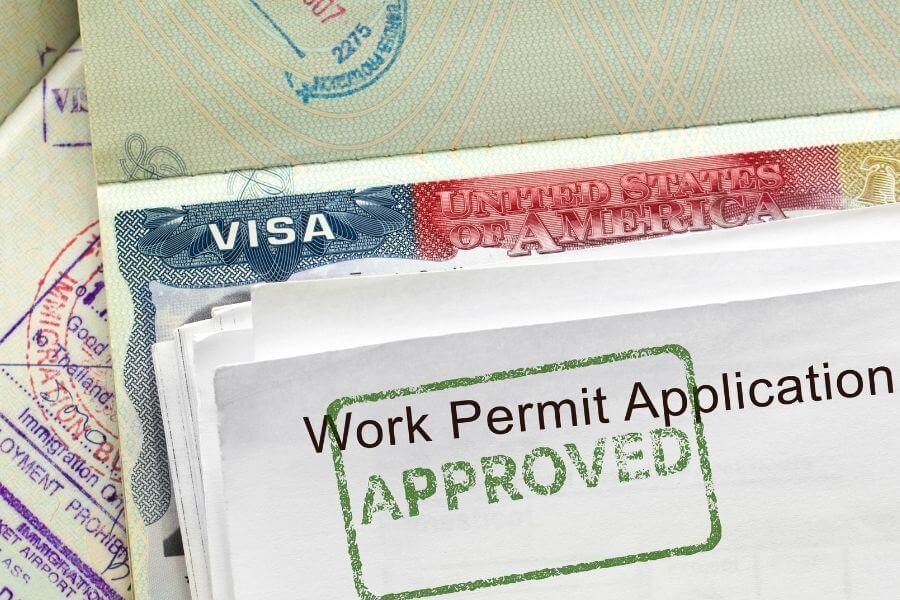
Priority Dates & Visa Bulletin Explained
Priority dates and the Visa Bulletin are central components in the U.S. immigration process for family-sponsored and employment-based immigrant visa categories.
Here’s how they work:
Priority Date:
The priority date is essentially the applicant’s “place in line” for an immigrant visa.
- For family-sponsored and employment-based applications, the priority date is typically the date the petition (I-130 or I-140) was filed with the U.S. Citizenship and Immigration Services (USCIS).
- For petitions that require a Labor Certification, like the EB-2 or EB-3, the priority date is the date when the Labor Certification application was accepted for processing by the Department of Labor (DOL).
Visa Bulletin:
The U.S. Department of State (DOS) publishes the Visa Bulletin monthly. This bulletin indicates which priority dates currently have visa numbers available.
The Visa Bulletin lists “cut-off” dates for each category and country. If an applicant’s priority date is earlier (i.e., older) than the listed cut-off date for their specific category and country, then they can move forward with their immigrant visa application or adjustment of status.
Here are some more considerations:
- Annual Visa Caps and Backlogs: There are annual limits on the number of immigrant visas available for each category and country. These caps can lead to backlogs, especially for countries with high numbers of applicants. If more people apply in a specific category and from a particular country than there are visas available for that year, a backlog or “waiting list” forms. The Visa Bulletin‘s cut-off dates reflect this backlog.
- Checking the Visa Bulletin: Applicants need to regularly check the Visa Bulletin to see if their priority date becomes current. The bulletin has different charts: one for “Final Action Dates” (actual visa issuance at consulates or green card approval by USCIS) and one for “Dates for Filing” (when one can submit the adjustment of status application, if they are in the U.S.).
- Country-Specific Limits: The Visa Bulletin often lists countries like India, China, Mexico, and the Philippines separately because of the high volume of applicants from these nations, leading to longer backlogs for them compared to the “All Chargeability Areas Except Those Listed” category.
- Spillover: Sometimes unused visa numbers in one category or from one country can “spillover” to another category or country. This spillover can sometimes benefit countries with significant backlogs.
Understanding priority dates and the Visa Bulletin is essential for determining when an applicant can move forward with their green card application. The wait can vary from a few months to several years, depending on the category and the applicant’s country of birth.
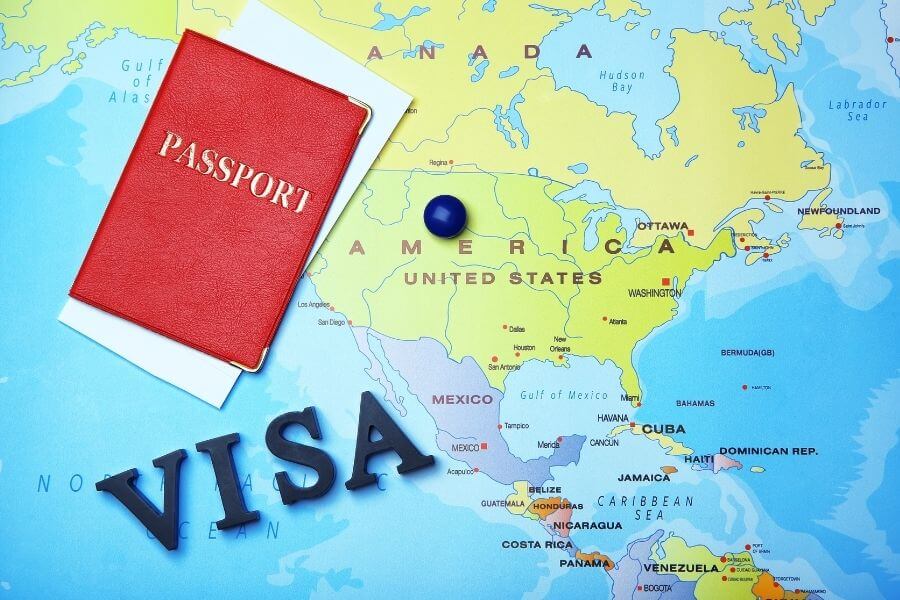
Premium Process Explained
The “premium processing” service (Form I-907) is an optional expedited processing service offered by the United States Citizenship and Immigration Services (USCIS) for certain immigration petitions. This service is available for specific visa categories and benefits both employment-based and certain family-sponsored applicants. Here’s how premium processing works:
| Eligibility | Form I-129: For non-immigrant visa categories (e.g., H-1B, L-1, O-1). Form I-140: For EB-1, EB-2, EB-3 categories. |
| Filing the Request | Submit Form I-907 with a filing fee of $2,500. |
| Processing Time | 15 calendar days. Within this, you’ll receive a decision (approval, denial, RFE). |
| Benefits | Expedited processing. Ability to monitor case status online and get email notifications. |
| Possible Outcomes | Approval, denial, RFE, or Notice of Intent to Deny (NOID). |
| Refund for Non-Compliance | If USCIS doesn’t process within 15 calendar days, they may refund the premium processing fee. |
It’s important to note that USCIS occasionally suspends premium processing for certain visa categories or petitions due to workload or policy changes. Therefore, it’s a good practice to check the USCIS website for the most up-to-date information on the availability of premium processing for specific forms and visa categories.
Eligible Family Members of EB-3 Visa Holders
Yes, if you are the primary beneficiary of an EB-3 visa petition, certain members of your family can accompany you to the U.S. or obtain derivative green cards based on your EB-3 status. Here’s how it works:
Eligible Family Members:
- Spouse: Your legally married spouse can apply for a derivative green card.
- Children: Your unmarried children under the age of 21 can also apply for derivative green cards.
Application Process:
When your EB-3 priority date becomes current, as indicated by the U.S. Department of State’s Visa Bulletin, you can file an application for Adjustment of Status (Form I-485) if you are already in the U.S. Simultaneously, your eligible family members can file their I-485 applications.
If you and your family members are outside the U.S., you’ll undergo consular processing for your immigrant visas. Your family members can apply for their immigrant visas at the same time.
Benefits for Derivative Beneficiaries:
- Work Authorization: Your spouse can apply for an Employment Authorization Document (EAD), which allows them to work in the U.S. while waiting for the green card application to be processed.
- Travel: Your family can also apply for Advance Parole, allowing them to travel outside the U.S. and return while their I-485 applications are pending.
- Green Cards: Once the primary applicant’s green card is approved, the derivative beneficiaries (spouse and eligible children) also receive their green cards, granting them permanent residency in the U.S.
Continuation of Relationship:
The relationship with the derivative beneficiaries (spouse and children) should remain valid throughout the process. For example, if a child turns 21 or gets married before receiving the green card, they may no longer qualify as a derivative beneficiary under the Child Status Protection Act (CSPA) provisions, depending on specific circumstances. Similarly, if the primary beneficiary gets divorced before the spouse receives the green card, the spouse will no longer qualify.
Remember that each family member’s application will incur separate fees, and the green card process can sometimes take years. Planning ahead and understanding the implications for family members is crucial.
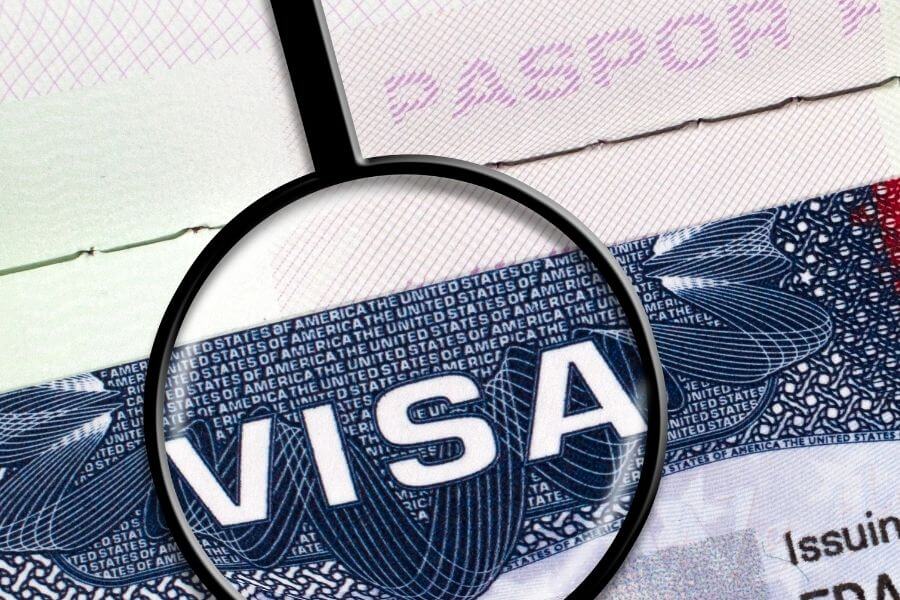
Changing Employers During the EB-3 Application Process
It’s possible to change employers during your EB-3 visa application, but it’s bound by specific rules, many of which are determined by the American Competitiveness in the 21st Century Act (AC21):
| Application Stage | Implications |
| Before I-140 Approval | Changing jobs can be risky. The new employer would generally need to start the process from the beginning. Original employer might also withdraw the I-140. |
| After I-140 Approval but Before I-485 Filing | Changing jobs can jeopardize your application. Original employer can withdraw the I-140. New employer might need to restart the process but could retain the original priority date. |
| After I-485 Adjustment of Status Filing | AC21 allows job changes if your I-485 application for adjustment of status has been filed and pending for at least 180 days AND the new job is in the same or a similar occupational classification as the job. |
AC21, enacted in 2000, reformed the H-1B visa program and employment-based green card process. Key provisions include H-1B portability, cap exemptions, green card portability, extensions beyond the 6-year H-1B limit, exemptions from per-country limits, and increased powers for labor investigations. It aimed to make the U.S. more competitive in attracting global talent.
Implications of Losing Your Job During the EB-3 Application Process
Losing your job while your EB-3 application is pending can be a concerning situation, as the EB-3 visa is employment-based and tied to a specific job offer. The consequences of losing your job largely depend on the stage of the application process:
| Application Stage | Implications |
| During the PERM Labor Certification Process | Job loss halts the process. The employer cannot continue with PERM, and you can’t use it for a future I-140 petition. |
| After PERM Approval but Before I-140 Approval | The employer might withdraw the I-140 petition or USCIS may deny it, since it’s based on a future job offer. |
| After I-140 Approval | If the I-140 remains unrevoked for at least 180 days, AC21 portability provisions come into play, allowing job changes under specific conditions. |
| After I-485 Adjustment of Status Filing | If the I-485 has been pending for less than 180 days, job loss may lead to denial. If pending for more than 180 days, AC21 can apply. |
If you find yourself in a situation where you’ve lost your job or are considering changing employers during the EB-3 application process, it’s crucial to consult with an immigration attorney. They can provide guidance tailored to your specific circumstances and help navigate potential options.
Traveling Outside the U.S. While EB-3 Application is Pending
Can you travel outside of the USA while your EB3 visa is pending?
Yes, you can travel outside the U.S. while your EB-3 application is pending, but there are important considerations to keep in mind to ensure you don’t jeopardize your ongoing application.
To travel internationally while the I-485 is pending, you need to apply for and obtain an Advance Parole (AP) document using Form I-131. It usually takes a few months for the AP to be approved.
Once you have the AP, you can use it to re-enter the U.S. after traveling abroad. It’s essential to ensure that the AP is valid during your entire duration of travel.
Here are some things to consider:
- Before I-485 Adjustment of Status Filing: If you’re in the U.S. on a non-immigrant visa (like H-1B or L-1) and haven’t yet filed your I-485 adjustment of status application, you can travel outside the U.S. using your current non-immigrant visa status. It’s essential, however, to ensure you maintain valid visa status and have a valid visa stamp to re-enter the U.S.
- After I-485 Adjustment of Status Filing: Once you’ve filed the I-485, traveling outside the U.S. without an approved Advance Parole document can result in the abandonment of your I-485 application.
- H-1B or L-1 Status: If you’re on an H-1B or L-1 visa and have a valid visa stamp, you might be able to travel and re-enter the U.S. Using that visa status even after filing the I-485, without necessarily using Advance Parole. However, it’s crucial to consult with an immigration attorney to ensure this is done correctly.
- Potential Risks: Even with a valid Advance Parole document, there’s a small risk when traveling internationally. Upon return, you’ll undergo inspection by U.S. Customs and Border Protection (CBP), and they have the authority to deny entry.
- Duration of Stay Outside the U.S.: Extended periods outside the U.S., even with Advance Parole, can raise questions about your intention to reside permanently in the country. It’s best to limit the duration of your trips abroad.
In all scenarios, if you intend to travel outside the U.S. during your EB-3 application process, consulting with an immigration attorney before doing so is advisable. They can provide guidance tailored to your specific circumstances and ensure that you’re aware of any potential risks.
Common reasons for an EB-3 Visa application to be denied
There are several reasons an EB-3 visa application (or, more specifically, an application for lawful permanent residency based on an EB-3 employment offer) can be denied. Here are some of the most common reasons:
- Issues with Labor Certification (PERM): Before filing an EB-3 petition with USCIS, the employer must obtain a certified Labor Certification (often referred to as PERM) from the U.S. Department of Labor. If there are mistakes in this process, like not meeting the advertising and recruitment requirements or inaccuracies in the provided information, the Labor Certification can be denied.
- Insufficient Qualifications of the Applicant: If the applicant doesn’t meet the job requirements as outlined in the Labor Certification, the petition can be denied.
- Employer’s Financial Inability: The sponsoring employer must be able to pay the offered wage as stated in the Labor Certification. If USCIS determines that the employer might not be financially stable enough to pay the salary, it could lead to a denial.
- Ineligibility Grounds: Common inadmissibility reasons include certain criminal convictions, health-related issues, prior immigration violations (such as overstaying a visa or misrepresentation), and security and terrorism concerns.
- Job is Not Permanent: The position being offered must be permanent in nature. Temporary or seasonal positions do not qualify for EB-3 classification.
- Incomplete or Incorrect Documentation: Any mistake or omission in the application package can lead to a denial. This is why it’s crucial to meticulously review all documentation before submission.
- Public Charge Ground: If the U.S. government determines that an immigrant is likely to become a “public charge” or rely on public benefits, the application can be denied. This determination is based on several factors, including the applicant’s age, health, income, education, and skills.
- Priority Date Issues: Sometimes, visa retrogression can occur, where more people apply for a visa in a particular category and country than there are visas available. In such cases, even if the USCIS approves the I-140 petition (Immigrant Petition for Alien Worker), the applicant will need to wait until a visa number becomes available based on their priority date.
- Fraud or Misrepresentation: If USCIS suspects or determines that any part of the immigration process involved fraud or misrepresentation, the application can be denied, and other severe penalties can apply.
- Issues from Personal Interviews: Sometimes, issues arise during the personal interview that can lead to visa denial, such as inconsistencies in statements or failure to provide satisfactory answers to the officer’s questions.
This is not an exhaustive list, and the reasons for denial can be varied and case-specific. If someone fears potential issues with their EB-3 application or has already received a denial, it’s strongly advised to consult with an experienced immigration attorney who can provide guidance tailored to their individual circumstances.
EB-3 Visa Cap
The total number of employment-based immigrant visas available each fiscal year across all categories (EB-1 through EB-5) is 140,000. Within the EB-3 category, the visas are further divided among its three subcategories:
- Skilled Workers: 28.6% of the total EB-3 annual limit.
- Professionals: 28.6% of the total EB-3 annual limit.
- Other Workers (Unskilled Workers): Allocated a maximum of 10,000 visas annually.
Country-specific backlogs for the EB-3 visas
Yes, there are country-specific backlogs for the EB-3 visa category. The U.S. has an annual cap on the number of green cards that can be issued in the employment-based categories, including EB-3. Moreover, there is a per-country cap, which means no one country can utilize more than 7% of the total available employment-based green cards in a year.
Countries most affected by these backlogs in the EB-3 category (and other employment-based categories as well) include:
- India: Historically has had one of the longest backlogs due to the large number of applicants.
- China: Also has significant demand for EB-3 visas, leading to backlogs.
- Philippines: Often faces backlogs, especially in employment-based categories related to healthcare professionals.
- Vietnam and El Salvador, Guatemala, and Honduras: In recent years, these countries started to hit their per-country limits, leading to backlogs.
- Other countries: While the majority of other countries typically remain “current” (meaning there’s no backlog), fluctuations in demand can cause temporary retrogressions.

EB-3 vs EB-1 & EB-2
How does the EB-3 differ from other employment-based visas like EB-1 or EB-2?
The EB-3 visa category is designed for skilled workers, professionals, and unskilled (or “other”) workers. Skilled workers must have at least two years of job experience or training, while professionals should hold a U.S. bachelor’s degree or a foreign equivalent.
Both categories should be coming for positions where qualified U.S. workers are not available. The “other workers” subcategory, typically for unskilled labor, has similar requirements but may face longer waiting times due to annual visa caps.
For all EB-3 applicants, a full-time, permanent job offer, and a Labor Certification from the U.S. Department of Labor are mandatory, which attests that there are no suitably qualified U.S. workers available for the proposed position.
In contrast, the EB-1 category targets individuals of extraordinary ability, outstanding professors and researchers, and multinational managers or executives. These individuals typically demonstrate national or international recognition in their fields and don’t need Labor Certification.
The EB-2 category is for individuals with advanced degrees or exceptional abilities in arts, sciences, or business. While Labor Certification is often required for EB-2 applicants, those who qualify for a National Interest Waiver can bypass this requirement.
Generally, EB-1 and EB-2 applicants, due to the specialized nature of their qualifications, face shorter waiting times compared to EB-3, especially for the “other workers” subcategory.
EB-3 Visa Benefits
The EB-3 visa, being an employment-based immigrant visa category, offers several benefits to its holders:
- Permanent Residency: One of the primary benefits of the EB-3 visa is that it leads directly to permanent residency (a green card) in the U.S. This means beneficiaries can live, work, and study in the U.S. indefinitely.
- Family Benefits: The primary beneficiary can also bring immediate family members, which include a spouse and unmarried children under 21 years of age, to live in the U.S. These family members can apply for Adjustment of Status (I-485) and obtain green cards as derivative beneficiaries.
- Employment Opportunities: Green card holders are free to work in any sector, industry, or role without the need for employer sponsorship, and they aren’t tied to a specific job or employer like many non-immigrant work visas. This provides flexibility and a broader range of employment opportunities.
- Access to Benefits: EB-3 green card holders are eligible for certain public benefits and can also apply for U.S. citizenship after meeting residency requirements.
- Travel Flexibility: Green card holders can travel in and out of the U.S. with relative ease, though they should be cautious about extended stays outside the U.S. which could be seen as abandoning U.S. residency.
- Education: Beneficiaries and their families have the right to study in the U.S., and they might qualify for in-state tuition rates at public educational institutions.
- Social Security: After working in the U.S. for a certain number of years, green card holders can access social security benefits upon retirement.
While the EB-3 visa provides numerous advantages, it also comes with responsibilities like paying taxes, abiding by U.S. laws, and periodically renewing the green card or opting for U.S. citizenship when eligible. It’s essential to understand both the benefits and obligations when considering the EB-3 path to U.S. residency.
EB-3 Visa FAQs
Being out of status in the U.S. complicates the EB-3 application. Although an employer can file an I-140 Immigrant Petition for you, being out of status typically renders you ineligible to adjust your status to a permanent resident within the U.S. using Form I-485.
Self-petitioning for an EB-3 visa isn’t allowed. An employer must sponsor you, starting with obtaining a PERM Labor Certification. Upon PERM approval, the employer files Form I-140 on your behalf. The process is employer-driven and tied to a specific job offer.
Yes, the EB3 visa leads to lawful permanent residency, granting you a green card. As a lawful permanent resident (LPR), you are a U.S. resident for tax and many other legal purposes. However, unlike U.S. citizens, LPRs can’t vote in federal elections.
While you can navigate the EB-3 process without a lawyer, it’s recommended to have one due to U.S. immigration law’s complexity.
The “Notice of Filing” is a PERM Labor Certification step. Employers must post a job opportunity notice for at least 10 business days, informing potential U.S. workers about a position for which they intend to hire a foreign national. It ensures transparency in the green card process.
An RFE from USCIS requests additional information or clarification. RFEs specify what’s missing, how to respond, and a response deadline, typically 30, 60, or 87 days. After USCIS reviews the RFE response, they continue processing the application or petition.
A NOID from USCIS informs an applicant or petitioner of unfavorable information that may result in denial. It outlines the concerns and gives an opportunity to address them, typically within 30 days. Receiving a NOID is critical, often prompting individuals to seek legal advice.
More Employment-Based Visa Guides:
- EB-1 Visa (outstanding professors, researchers, people with extraordinary abilities)
- EB-2 Visa (foreign professionals with advanced degrees or exceptional abilities in certain fields)
- EB-4 Visa (special immigrant)
- EB-5 Visa (immigrant investors)
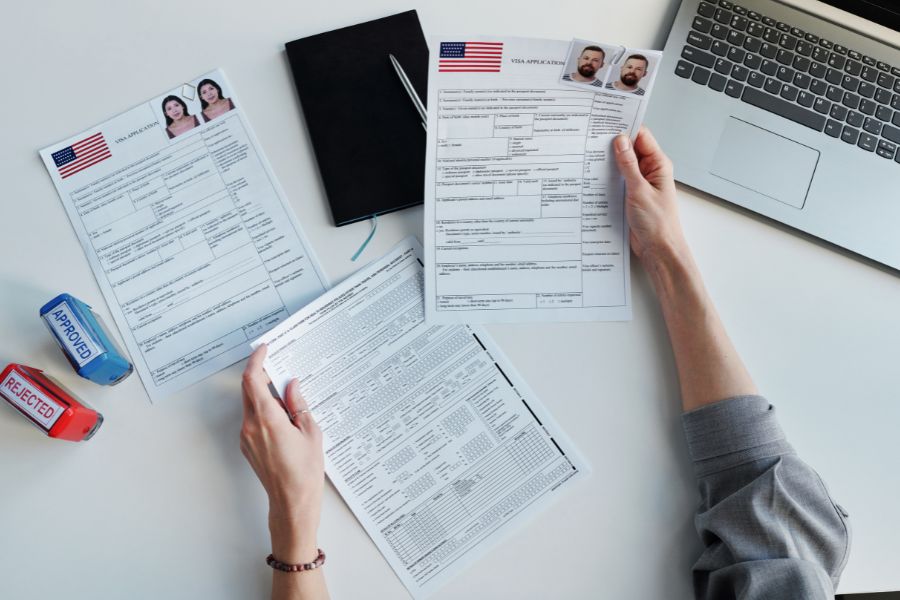
References:
